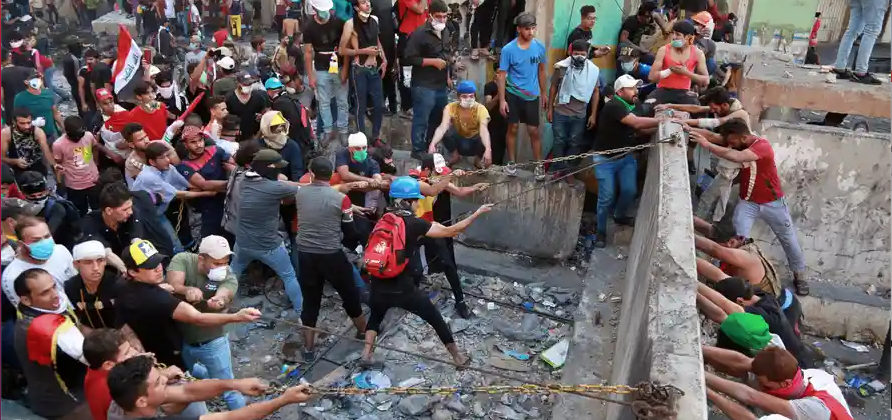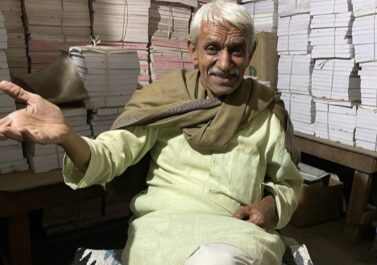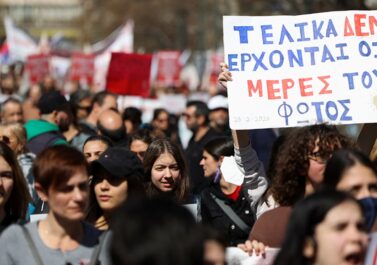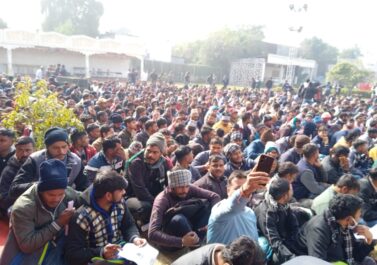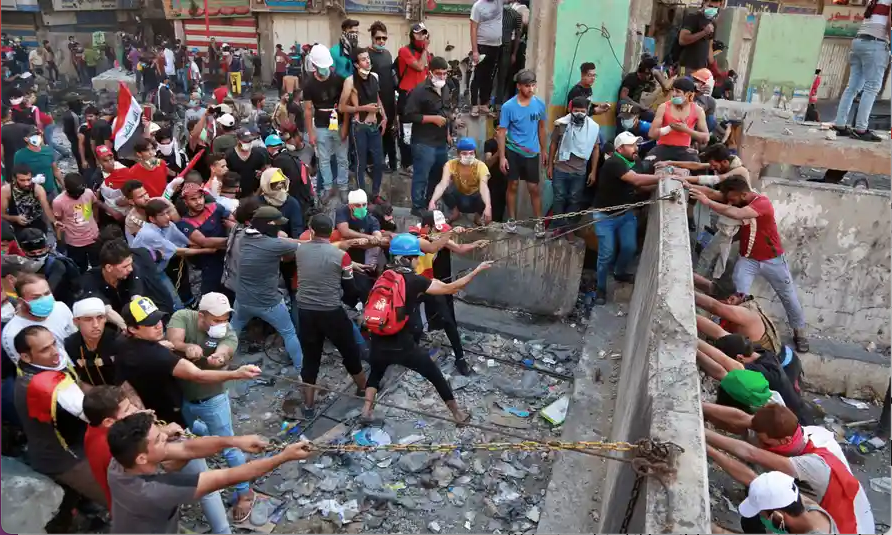
We’ve translated this article on recent struggles in the Middle East from issue no.107 of the German magazine Wildcat in order to emphasise the crucial changes that have happened since the ‘Arab Spring’. Since 2019, the social movements in the region have become more focused on peoples’ immediate material needs and have, in many cases, become more independent from middle-class and religious leaders. This is of particular importance in post-civil-war countries such as Iraq, Lebanon, but also currently Algeria, where a massive strike and protest wave is underway. Despite its tragic isolation, we also have to see the struggle of the working class in Palestine against state repression and violence within this international context. We have been rightly criticised for not having analysed the ‘local general strike’ more concretely, and we agree. We just fear that through military escalation, inter-faction fighting (Hamas – Fatah etc.) and usurpation of working class means of struggle (‘general strike’ supported by the ruling parties and middle-class associations), that the local rulers will manage, once again, like after the first and second Intifada, to channel proletarian anger into their own government project. This would further isolate the struggle in Palestine – the main isolation obviously being the repressive politics of the Israeli state – from the proletarian revolts that are currently happening in most other countries in the region. The issue is not that workers in Palestine should ‘listen to western politicos’, but that they are not cut off from the ongoing learning process of the working class in the region and beyond. Class movements learn internationally, we all learn.
“On the other hand, proletarian revolutions, like those of the nineteenth century, criticise themselves constantly, interrupt themselves continually in their own course, come back to the apparently accomplished in order to begin it afresh, deride with unmerciful thoroughness the inadequacies, weaknesses and paltrinesses of their first attempts, seem to throw down their adversary only in order that he may draw new strength from the earth and rise again, more gigantic…” (Marx, 18th Brumaire)
In 2019, people all over the world took to the streets against increases in fuel tax, fuel prices, fares … or, as in Lebanon, against a tax on Whatsapp calls. These price increases were all reversed. The Gilets Jaunes had opened this cycle of protests with their meetings and perseverance. The images of massive violence by the French state were also seen around the world. Below, we turn our gaze to the MENA (Middle East and North Africa) region; where presidents were ousted and governments toppled in rapid succession in 2019. No sooner was one flashpoint extinguished than a new one flared up elsewhere. The revolts had many things in common.
MENA
At first glance, the world has become more peaceful over the past 50 years. But this is not true for a broad strip from northwestern Pakistan to northeastern Nigeria; this area has been characterised by embargo policies, war, suicide bombings, and so on. Here, the neoliberal turn was accomplished by other means than, for example, in Italy, Mexico, France or Germany. The turn of the times in 1979 had opened the door to the global restructuring of class relations: it ranged from the ‘Volcker shock’ in the USA to the ‘opening’ of China, from Margaret Thatcher’s TINA (‘There is no alternative’) to the seizure of power by the Islamic counter-revolution in Iran.
Khomeini came to power because, after a month-long strike by Iranian oil workers, he assured the Western powers that he would stop communism and guarantee oil exports. The neoliberal turn was enforced in Iran during the eight-year war against Iraq; the minimum wage of workers was reduced below the 1970s level – in 1979 it had increased by 170%! Finally, in Iraq, the neoliberal turn was enforced by embargo and bombardments.
The mullahs’ counterrevolution in 1979, the attacks on the World Trade Center on September 11, 2001… time and again, this battered part of the world has influenced world history. It was also here that the first mass uprisings against the effects of the global crisis occurred in 2008 onwards. But the uprisings of the Arab rebellion, with the exception of Tunisia, were all, in the end, drowned in blood, which led to the emergence of the IS (Islamic State) and a large movement of refugees – again, both global political events.
Revolts without history?
The actors in these revolts, are mostly presented to us as being young people ‘without memory and without goal’. This is not only the bourgeois view from the outside, but often also an interpretation of leftists. [1]
Do the uprisings have a ‘memory?’ What do the protesters ‘learn?’. Referring to the Arab uprisings, Karim El-Gawhary says, “The autocrats have also learned how to better suppress uprisings and desires for change: The decisive question now will be: ‘Who learns faster – the repression or the rebellion?’’ [2] Here are a few thoughts on this below, based on events in Iraq, Lebanon, and Iran.
Change in the Movements
The 2009 movements in Iran and 2015 in Lebanon were middle-class movements – despite mass participation – both in terms of leadership and composition. The 2015 protests in Iraq [3] were also an expression of a middle class. The middle class seemed devastated by the economic crisis and successive wars. After the end of the UN sanctions, however, they re-emerged after decades of silence with their demand for a modern state structure. [4]
They were mainly concerned with political demands, elections and the like. In Iran, for example, slogans against poverty or for better working conditions tended to be rejected.
Iraq
The 2015 protests in Iraq were directed against the religious and sectarian political elites who had been brought to power in 2003.
In 2018, the next wave of protests erupted in Basra. This oil-rich province contributes to most of Iraq’s wealth, but suffers from a severe lack of public infrastructure and nonexistent basic services. The main differences from 2015 were that people refused formal leadership and centralised organisation and shunned political parties. Even broader was the so-called ‘October Revolution’ of 2019: an uprising throughout Iraq (except in some Sunni regions). These protests happened not just in the big cities, but everywhere, the focus being on social demands. Politically, this meant that the system as a whole was called into question; all politicians had to go. The global neoliberal economy, or in other words capitalism, was at the centre of peoples’ criticism. The earlier waves of protest had paved the way; the 2019 uprising picked up at their most advanced points.
Lebanon
Lebanon had also seen large demonstrations in 2015 in the so-called ‘garbage uprising’. The protests were mainly carried by Beirut’s middle class and had begun when piles of garbage began piling up in the streets whilst politicians remained inert. The demonstrations were broken up, sometimes violently, and the rulers managed to survive the crisis despite great divergence among themselves.
Thereafter, there were repeated smaller protests against poor living conditions, for women’s rights, environmental concerns, and so on. In Lebanon, the 2019 movement also spread throughout the country. On the 20th of October, nearly a third of Lebanon’s population – 1.7 million people – took to the streets nationwide. It was the largest mobilisation since the 2005 ‘Cedar Revolution.’ By 2015, the elaborate religious/ethnic division of power had already reached its limits. The 2019 uprising demanded the end of this sectarian system of rule. The strong participation of Shiites in the protests refuted the prejudice that they all religiously follow Hezbollah and are part of the clientelist network of the Amal movement (a Shia based political party).
Hezbollah’s crackdown on the protests reinforced this insight – the slogan ‘All means all’ (The entire elite must disappear) was a clear expression of this. Hezbollah tried to portray events in Lebanon as quite different from those in Iraq, where the movement openly demanded ‘Iran out’ and the repression had a much stronger dimension, with hundreds of dead protestors. This portrayal was nullified by the Iranian religious leader Khamenei, of all people, who put the uprisings in Lebanon and Iraq on the same level, calling them ‘satanic conspiracies’. [5]
There were also demonstrations in the the two Shiite party (Amal and Hezbollah) strongholds, and people demonstrated against them. A slogan made the rounds that shortly before these protests no one in these cities would have dared to utter publicly: ‘Nabih Berri, you are a thief!’ (Nabih Berri is the Amal party leader, a multimillionaire and parliamentary speaker since 1992.)
The more the social problems came to the fore, the clearer it became that the ruling elites had profited – even from the high national debt. The former ‘Switzerland of the Middle East’ has long been unable to pay for consumer goods imports without capital inflows from abroad. Until then, this money came primarily from the 14 million Lebanese diaspora, who own about 40% of the deposits in Lebanese banks. The 14 largest Lebanese banks hold deposits of about $200 billion, four times Lebanon’s gross domestic product (GDP)! The private banks and the central bank together hold over 85% of Lebanon’s public debt and earn from the enormous interest rates on government bonds. The banks are owned by influential businessmen with close ties to the political elite. In 2019, the inflow of foreign capital stopped and a run on deposits began. Government revenues collapsed. Such a ‘byzantine system of rule’ cannot meet social demands at all.
The protests continue. At the end of January (2021), there were again days of demos in Tripoli. A visibly upset man yells into the camera and addresses the powerful: People want to eat and they want education. ‘In ten years,’ he shouts, ‘we’ll throw you all out!’
Iran
Following the drastic increase in petrol prices in October 2019, people took to the streets in at least 150 cities. Similar to 2017, the protests were quickly directed against the system as a whole, only much more violently.
The regime reacted with massive violence and turned Iran into a ‘dark spot’ by imposing an internet lockdown. The regime compared the events to a war and gave them names like ‘Operation Mersad 2, Karbala 4’. After a few days, they had stifled the uprising. We are ‘not able to change anything with such a cruel system – unless everyone joins in!’ said one young demonstrator.
Tunisia
The anniversary of the toppling of dictator Ben Ali is held on the same day that Tunisia has traditionally celebrated the Revolution and Youth Day holiday. On the tenth anniversary on the 14th of January, there were new protests in addition to the demos: they began in the capital Tunis and soon reached the whole country. Young people threw stones and molotov cocktails at police officers, set fire to car tyres and erected street blockades. They were not impressed by a curfew that lasted several days. More than 600 people were arrested. In previous years, the rallies and strikes at the beginning of the year were mostly civilised protests against tax and price increases. This time, there was no common slogan; in the streets, people gave free rein to their anger and disappointment. Again and again, looting took place. The Corona pandemic has further exacerbated the chronic economic crisis, which young people suffer from the most; more than a third of young Tunisians are unemployed.
[Since this article was written, a large strike and protest movement has shaken Algeria, another post-civil-war society where the fear of both the police state and islamist groups is deeply rooted. Working class people now seem to have overcome this fear. The movements in Iraq and Lebanon must have been helping this. The current uprising in Colombia, another post-civil-war country on the other side of the globe, is further proof of the double crisis the ruling class is in: the economic crisis has undermined by neoliberal and social democratic models, which paves the way for political repression – but even political repression doesn’t seem to be working anymore…]
Changing conditions
In the ten to twelve years that span the movements in these countries, the framework conditions have changed considerably. With the end of the commodity boom (around 2014), social programs were drastically reduced. Almost all states have cut public services, eliminated subsidies for basic needs such as food, and privatised state-owned industries. Even in Tunisia, despite the much-lauded ‘revolution’ of 2011, austerity policies have continued (hiring freeze in the public sector, cuts in subsidies, privatisations, ‘market opening’ …).
Since 2013, the rulers of these countries and worldwide have had to ‘dare more dictatorship’ [old social democratic party election slogan in Germany: ‘dare more democracy’]. We saw the end of the ‘Arabellion’, the repression of the Gezi Park movement in Turkey, the shooting of demonstrating miners in Marikana/South Africa, the civil war in Libya, Syria, Yemen … and the rise of the IS. From Al-Sisi to Putin, from Erdogan to Xi Jinping, from Modi to Trump…
Especially in the countries that have been in a permanent state of war since the 1980s, the regimes have been organising a kind of ‘strategy of tension’ with their secret militias, blurring the line between them and foreign provocateurs. We still do not know how, on the second day of the movement in Iran in November 2019, some banks and gas stations suddenly caught fire. And what part the People’s Mujahedin (who cooperate with the USA, Israel and Saudi Arabia) had in it.
But the fact that we’re see burgeoning dictatorships is only one side of the coin. They have to use more repressive policies because they are running out of economic polices to placate their citizens. Privatisation, for example, has already progressed too far, undermining the reproduction of the working class; in Iran, one parent works just to pay for their kid’s school fees. It is therefore not possible to raise money through further expropriations, as was the case in the 2007/8 crisis.
In the last ten years, many proletarians have experienced the environmental crisis caused by government policies, US foreign policies and neoliberal measures as a social catastrophe: floods, drought, water scarcity…
The composition of the population has also changed. In Iraq, there are more and more ‘sushi’ children: one parent is Sunni, the other Shiite. According to estimates, they make up more than two out of a total of more than six million Iraqi families. Demographic development is also not going according to rulers’ wishes. In Iran, women are having fewer children; Khamenei had to admit that his calls over the last ten years for Iranian women to bear more children had been of no avail, and now the trend must be changed by legislation. Every year, 300,000 women have abortions (mostly illegal).
During these years, the political alternatives have also evaporated: The so-called ‘post-Islamism’, as a hope for a ‘peaceful Islam,’ was stillborn; this can be seen in its former hopefuls: Mursi, Erdogan, Ruhani…. Since the Arab Spring, the major trade unions (e.g. in Egypt and Tunisia) have increasingly adapted to, or come to terms with, the system. [6] For example, in Egypt, after the military coup in 2013, Abu Eita, a prominent co-founder of the administrative workers’ union and symbol of the movement for independent trade unions, became the new labor minister in the military state.
A final point is the means of communication between the protestors. Smartphones and the use of ‘social media’ have become widespread and are used to exchange information ever more quickly. Workers around the world use these means in chat groups for discussion and self-organisation. Especially in repressive countries like Iran, protests can only be organised with such means.
Learning processes
The historical memory of the global protests of recent years is best expressed by a slogan from the model country of neoliberalism, Chile: ‘It’s not about 30 pesos, it’s about 30 years’. The view that, ’in ten years we’ll throw you all out’, expresses the fact that revolution does not happen overnight. Movements learn from past mistakes, as well as from experiences in other countries.
The 2018-19 movement in Sudan learned from the experience in Egypt and did not fall into a ‘tamarod trap’ of the military [7] like those in 2013. The protestors in Sudan emphasised the importance of continuing protests and sit-ins, even after the military had ousted dictator al-Bashir from office. The resistance committees from below were decisive in this. [8]
Religion and political Islam, which still played an important role in the ‘Arab Spring,’ have now not only receded into the background, but the movements are beginning to see them as an enemy. The protests have emancipated themselves from the traditional Friday prayer as the starting point of the demos – and not only because of the experiences with the civil war in Syria, IS, Mursi, Erdoğan. The sectarian and ethnic divisions themselves were recognised as a hindrance, and are being increasingly overcome in the movements.
Iran, Iraq, Lebanon
The fact that the October 2019 uprisings in all these three countries happened simultaneously and with similar triggers was no coincidence. Almost all Arab satellite channels can be received openly in the border region. To prevent direct contact, the border crossing near Basra was immediately closed. The demonstrations in Iraq triggered a wave of joy in southern Iran. There were discussions between protesters in both countries on social networks. There, the hope was expressed again and again that it would be possible to join forces beyond borders. This first ‘connection from below’ was cheered by the activists in the revolts of the three countries.
Workers and unemployed young people organised joint blockades of important ports and industrial areas, which was a new development and signified an important step of the social movement linking up with the industrial working class, whose ‘structural power’ has weakened in the wake of the neoliberal attacks.
One of the centres of petrochemical and labour struggles in the south is the port city of Mahshahr in Iran. Gas and oil are exported here from what is the country’s largest oil refinery. The poor, mostly unemployed youth from the suburbs (45% of the population here is Arab) have blocked the important connecting roads (also for imported goods) day and night, making the industrial centres and several of the country’s most important ports inaccessible and practically on strike. (Unfortunately, we have no reports on what was going on in the factories there). In the city, the young people took the goods from the blocked trucks and distributed them. After three days, the regime ordered tanks to advance; according to various estimates, between 50 and 150 people were shot during the retaking of the city.
In the port city of Umm Qasr in Iraq (also on the Persian Gulf and about as important as Mahshahr), such blockades by young people and oil workers occurred repeatedly. Here, too, the regime had to use military force to break up the blockade of the city.
In the municipality of El Kamour in Tunisia – which is under military control because the largest oil reserves are located in this desert fringe area – thousands of young people have been demonstrating regularly since 2017 with sit-ins for work … and have built up forms of democratic self-organisation that protect them from party-political association. After demonstrators blockaded the oil plant there on the 16th July 2020 and shut it down for a period of 117 days, the government signed an agreement that met many of their demands. [9]
In 2019 – and even less so in 2020 – there was no enthusiastic ‘spring’ anywhere, but rather a sober, globally ongoing wave of struggle. In it, even old leftwing parties are partly perceived as a hindrance. Through its alliance with the Shiite populist Sadr, for example, the Iraqi Communist Party has lost a lot of trust, which could be clearly observed in Tahrir Square in Baghdad.
In their movements, these proletarians also recognise the limitations of national solutions. They overcome confessional and ethnic divisions and transcend the national and regional (Arab) framework. In these learning processes – from France to Haiti – they become the subject of world history.
———-
Footnotes:
[1] After the defeat of the Autonomia in Italy, Negri had also begun to argue against the concept of ‘proletarian memories’: these were ‘today only the memories of the gravedigger’. According to him the ‘rejection of memory’ was the prerequisite of liberation. This is the first step towards opportunist or wishful politics.
[2] Karim El-Gawhary, Repression und Rebellion: Arabische Revolution – Was nun? Vienna 2020.
[3] According to the sociologist Ali Taher Al-Hamoud.
[4] See The International and Political Journal, 2017, Issue 35-6. Abstract at: www.iasj.net.
See also the article in Wildcat 100.
[5] The slow break-up of Hezbollah’s hegemony over the Shiite population was demonstrated, for example, at the funeral of the murdered Hezbollah critic Lokman Slim in February 2021. The journalist and publisher had worked with Medico International for many years. In the fall of 2019, he and others organised a tent at the central protest camp in Beirut where political debates were held – until Hezbollah infiltrated and destroyed the camp. On February 3, 2021, he was assassinated by multiple gunshots.
[6] Take Tunisia, for example: The powerful general trade union (UGTT) with three-quarters of a million members – Tunisia has a population of around eleven million – and for DGB [German TUC] Chairman Reiner Hoffmann ‘a star among Arab trade unions,’ has now founded a national dialogue quartet with the Union of Industry, Commerce and Crafts (UTICA), the League for Human Rights (LTDH) and the National Lawyers Association, which was awarded the Nobel Peace Prize in 2015 for saving the country from civil war. During the tenth-anniversary protests, it called for ‘calm,’ meaning an end to the protests. See www.labournet.de
[7] In the first half of 2013, social struggles intensified in Egypt, with the police and military taking increasingly massive action against them. However, the signature campaign launched in May 2013 under the name Tamarod (rebellion) to depose Mursi only gained traction when leftists and liberals joined in almost completely. The two independent trade union associations even provided their infrastructure. Half a million people took part in the June 30 demonstrations in Cairo against Mursi. Against this backdrop, the military’s coup could be passed off as legitimised by the ‘people.’ (See Wildcat 95)
[8] See the book by Jade Saab, Azza Mustafa and Sara Abbas: Learning from Uprising in Africa and Asia. The chapter can be found at www.newframe.com
[9] According to Le Monde Diplomatique, January 2021, there is a parallel to the movement in Chile and the strike in the port city of Antofagasta, see the good article in the junge welt from the 8th of February 2020, ‘In Chile’s mining region of Antofagasta, the class struggle has flared up particularly violently’.
